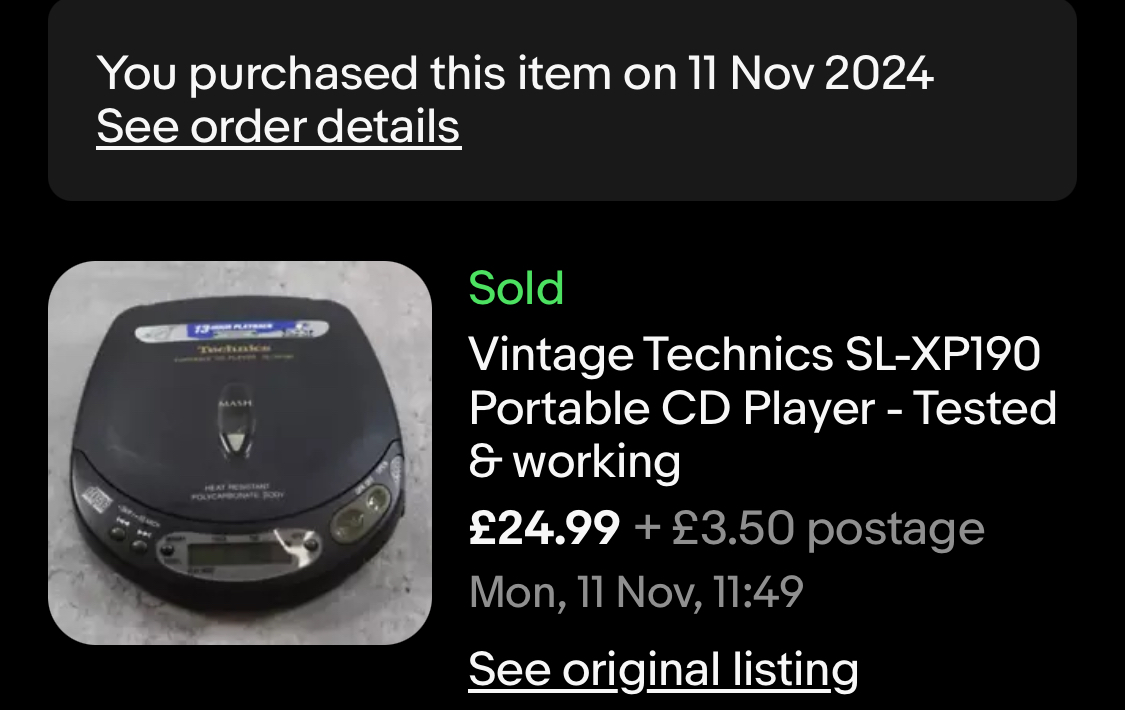ChatGPT and Vintage CD Players
ChatGPT vs. The Technics SL-XP190
The Technics SL-XP190
I can’t recall why I wanted one of these - but I clearly did - as an ebay alert popped saying one was listed for the rather reasonable ‘buy it now’ price of £24.99. I must have set it for some reason, aeons ago, so clicking buy was a no-brainer - the winter months are coming and it’s time for indoor hobbies. After all, it still had the original stickers on it from the factory - how much could it have been used?

I was pleasantly surprised - it all worked - nothing for me to tinker with here, it was in amazing condition.
Let’s invent some problems to be fixed then! Actually, as capacitors age they start to breakdown, electrolytics don’t live forever. Generally when I restore a vintage CD player the ones in the power supply are replaced, and any electrolytics in the signal path. In order to do that, we need to know where to look, and back in the 90’s they still used to issue service manual for devices…
Finding the Service Manual
I couldn’t find the book for the SL-XP190, but I did find the one for the SL-XP160. A close enough match, if you are interested in the differences between the models they’re here.
The service manual for the SL-XP160 is here
Audio Output Stage
The last stage before the headphone output is the headphone amplifier, powered by the TDA 1308TT. The first use for chatgpt in a time saving capacity is to tell me all about it… it’s great being ablw to ask questions like ‘if I changed the TDA1308 for the LM4562 what characteristics change ?’ and have details come back at you, without having to flip between datasheets and find the information you’re after. Time saved here is not minor…
| Characteristic | TDA1308 | LM4562 | Result |
|---|---|---|---|
| Fidelity | Good | Excellent | Significant audio quality boost. |
| Current Drive | High | Moderate | May need buffers for headphones. |
| Power Supply | Low voltage (1.8V–6V) | Higher voltage (±5V–±17V) | Requires power supply upgrade. |
| Noise/Distortion | Moderate | Ultra-low | Quieter, cleaner audio. |
| Stability | Optimized for simplicity | Sensitive to layout/load | Requires careful design. |
Pasting Schematics
I was amazed the first time I pasted a schematic and found that chatgpt could follow them. I uploaded screenshots of each of the pertinent pages, and asked it to analyse it.
Capacitor Shopping List
Paste in all the schematics, ask it to identify all electrolytics which would benefit from being replaced.
You absolutely should never trust the output, e.g. C711 and C712 in the datahseet are 10uF, but AI identified them as 100uF!
| Ref. No. | Part No. | Capacitance | Voltage Rating | Description | Circuit Section |
|---|---|---|---|---|---|
| C12 | RCE1AKA4701G | 47 µF | 10V | Power supply decoupling for clean DC voltage near the IC. | Power Supply |
| C13 | RCE0JSA4701X | 47 µF | 6.3V | Signal coupling to block DC in the audio path. | Signal Path |
| C14 | RCE0JKA1011V | 100 µF | 6.3V | Local decoupling to stabilize voltage near amplifier stages. | Amplifier Decoupling |
| C15 | ECA1C101I | 0.1 µF | 16V | Power filtering capacitor near the battery/DC input. | Battery/DC Input |
| C16 | ECA1EAK4R7I | 1 µF | 16V | Power supply decoupling for the regulator circuit. | Power Supply |
| C605, C606 | ECA1C4701I | 10 µF | 16V | Power supply decoupling for the regulator circuit. | Power Supply |
| C607, C608 | ECA1HL681KBN | 680 pF | 50V | Decoupling and smoothing in the muting/audio output circuit. | Audio Muting Circuit |
| C709, C710 | ECA0GKA221 | 220 µF | 4V | Output coupling capacitors for left and right channels of headphone amplifier. | Headphone Amplifier |
| C711, C712 | Unknown | 10 µF | 6.3V | Signal coupling to block DC from the input signal. | Headphone Amplifier (Input) |
